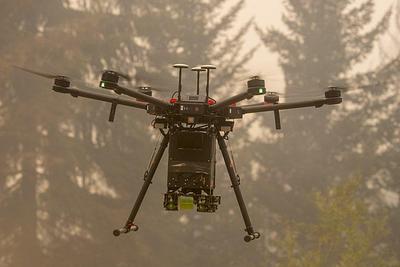
Author: Steve Smith, Head of Smart Places at FarrPoint
There have been 745 wildfires in the UK so far this year, up from 247 in the whole of 2021, with predictions suggesting these types of events are going to become more frequent in the future. This would result in wide-ranging implications that reach beyond the obvious damage to the environment and property. The risks include impacts on food security, utility networks and the significant costs associated with the emergency response, restoration and impact on the local economy. If allowed to continue unchecked, events like this will continue to cause havoc.

Forest fire in North London, Epping Forest
A (this will open in a new window)Fire and Rescue Statistics report published in 2012 stated average costs to the Fire and Rescue Service of vehicle response to all vegetation fires in the UK was up to £55 million per annum, which when adjusted for inflation would equate to c.£77m in 2022. Suppression costs of moorland fires are high due to problems of access and water supply—up to £1 million for a large peat moorland fire. In addition, ecological restoration of peatland burn scars in the Peak District National Park which were the result of a wildfire in Northwest England has cost over £12 million. The carbon cost of burnt peatland releasing stored carbon to the atmosphere can also be significant and to be avoided.
Wildfires are nothing new, we’ve seen them in the UK before, and they are a regular occurrence in other parts of the world. Countries such as Italy, Portugal, Germany and the USA have been forced to adapt to this constant threat and now have systems and resources in place, ready to react when incidents happen. But what about prevention?
We already have an abundance of data that when used properly can highlight the risk of wildfires and there is a clear opportunity to implement and deploy various Internet of Things (IoT) solutions in areas of high risk. These solutions can provide early warning alerts when a fire is detected, enabling a faster response and the opportunity to extinguish or contain the fire before it develops into a major incident.
The potential economic and environmental savings from early detection are significant. Still, they can only be achieved with the correct systems, processes, and governance in place to enable the appropriate resources to respond quickly.
For example – by deploying IoT sensors in areas that are susceptible to wildfires, it is possible to provide early warning of a fire by detecting gases during the smouldering phase of a fire before it fully takes hold, with the aim of reducing the reaction time of fire services to within the critical first hour, providing an opportunity to contain the blaze before it spreads uncontrollably. Another example is in the use of drones, which when equipped with the right sensors can provide real-time data on the topography of an area, visual pictures and videos, heat signatures, and fire hotspots enabling firefighters can make intelligent decisions based on data – saving lives, economies, communities, and ecosystems in the process.

The UK needs to act now so that we are prepared for future incidents, and we can learn a lot from other parts of the world where experience has been built up over many years.
At FarrPoint, we’re here to help find the right smart solutions to our clients’ problems: whether it’s traffic or air quality monitoring or even wildfire management. We work collaboratively with our clients to understand the challenges faced so that we can identify the most appropriate ways to quantify the real-life benefits that the solution will bring.
Our wide range of skills allow us to develop smart technology projects from small-scale pilots, to creating full business cases for long-term deployment and monitoring the benefits achieved.
Find out more about our smart places and IoT services.
Connectivity is important. It drives business and society, bringing communities and commerce together. That's why we use our insight and experience to connect people and business.